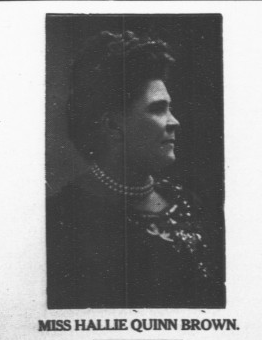Hallie Quinn Brown facts for kids
Quick facts for kids
Hallie Quinn Brown
|
|
|---|---|
 |
|
| Born | Hallie Quinn Brown March 10, 1850 Pittsburgh, Pennsylvania, U.S. |
| Died | September 16, 1949 (aged 99) Wilberforce, Ohio, U.S. |
| Resting place | Massies Creek Cemetery, Cedarville, Ohio |
| Occupation | educator, writer, activist |
| Language | English |
| Nationality | American |
| Alma mater | Wilberforce University |
Hallie Quinn Brown (born March 10, 1850 – died September 16, 1949) was an important American educator, writer, and activist. She was born in Pittsburgh, Pennsylvania. When she was young, her parents, who had been enslaved, moved their family to a farm in Chatham, Canada, in 1864. Later, in 1870, they moved to Ohio.
In 1868, Hallie began studying at Wilberforce University in Ohio. She graduated in 1873 with a degree in Bachelor of Science. She was the first woman to earn a Master of Science degree from Wilberforce University in 1887.
Hallie Q. Brown started her career teaching in a country school in South Carolina. She also taught a class for older people. Later, she taught in Mississippi and Dayton, Ohio. She became a professor at Wilberforce University in 1893. She also traveled to give lectures and speeches.
The Hallie Q. Brown Community Center in Saint Paul, Minnesota, opened in 1929. It was named in her honor to serve the community. The library at Central State University in Wilberforce, Ohio is also named the Hallie Q. Brown Memorial Library.
Contents
About Hallie Quinn Brown
Hallie Quinn Brown was born in Pittsburgh, Pennsylvania. She was one of six children. Her parents, Frances Jane Scroggins and Thomas Arthur Brown, were formerly enslaved people. Her brother, Jeremiah, later became a politician in Ohio.
When Hallie was young, her family moved to Ontario, Canada. She then attended Wilberforce University. She earned her Bachelor of Science degree in 1873. There were six students in her graduating class.
Hallie Quinn Brown was a dedicated member of the African Methodist Episcopal Church. She passed away on September 16, 1949, in Wilberforce, Ohio. She is buried at Massies Creek Cemetery in Cedarville, Ohio.
Her Work and Service
As an Educator
Hallie Brown believed that teaching was very important, especially in the South. She left her home to teach on a plantation in South Carolina. She taught many children from nearby farms. She also taught a class for older people, helping them learn to read the Bible.
Next, she led a school on Sonora Plantation in Mississippi. The school building had no windows, and rain would come inside. Hallie couldn't get help to fix it. So, she and two older students gathered cotton seeds and mixed them with earth. They made a plaster and used it to fill the holes themselves.
Her skills as a teacher became well-known. She then taught in Yazoo City. Because of problems in the area, she had to return North. She taught in Dayton, Ohio, for four years. Due to her health, she stopped teaching for a while.
Hallie was asked to travel and give lectures to support her university, Wilberforce. She spoke at many places, including Hampton School in Virginia. She also studied elocution, which is the art of clear and expressive speaking. This helped her become an even better speaker.
She served as dean of Allen University in South Carolina from 1885 to 1887. She was also the principal of Tuskegee Institute in Alabama from 1892 to 1893. In 1893, she became a professor at Wilberforce. She often gave speeches about African American issues and the temperance movement. The temperance movement worked to reduce or stop the use of alcohol. She spoke at international conferences in London in 1895 and 1899. She even performed for Queen Victoria in 1897.
As a Speaker and Performer
For several years, Hallie traveled with "The Wilberforce Grand Concert Company." This group helped raise money for Wilberforce College. She performed for thousands of people. She had a powerful voice and could change it to fit her stories.
As a public speaker, Hallie would excite her audiences. When she told funny stories, she made people laugh a lot. When she told sad stories, she often made her audience cry.
As a Reformer and Activist
In 1889, Hallie Brown spoke about her belief in the abilities of Black women. She stressed the need for women teachers to help educate "this great nation of women." She suggested that husbands should support their wives' education. She also spoke about the need for equal education for women. This was the start of her work as a women's rights advocate, which included fighting for the right to vote.
In 1893, Hallie presented a paper at the World's Congress of Representative Women in Chicago. Four other African American women also spoke at this important conference.
Hallie Brown helped start the Colored Woman's League in Washington, D.C. This group later joined with others to form the National Association of Colored Women in 1896. She was president of the Ohio State Federation of Colored Women's Clubs from 1905 to 1912. She then became president of the National Association of Colored Women from 1920 to 1924.
She spoke at the Republican National Convention in 1924. Later, she helped lead campaign work among African-American women for President Calvin Coolidge.
Her Books
Hallie Quinn Brown wrote several books:
- Bits and Odds: A Choice Selection of Recitations (1880)
- First Lessons in Public Speaking (1920)
- Tales My Father Told Me, and Other Stories (1925)
- Homespun Heroines and Other Women of Distinction, (1926)



